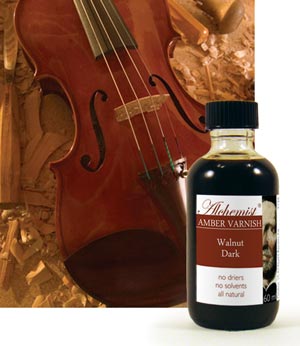 |
Since Alchemist chooses not to incorprate any driers in our products we are able to give the user the freedom to use the varnish in a way you feel comfortable with while simultaneously increasing the shelf-life for the non-frequent users. There are basically two approaches possible. A slow drying apporoach whereby less driers are used but including the use of a UV light box (drying cabinet). Such a way is described below by award winning luthier David Chrapkiewcz. The second approach results in a faster drying time but with the use of a higher ratio of driers (preferred by most users).
|
Note about oil varnishes:
Due to the oil content of the varnish, these mediums should not be applied to the soundboards of musical instruments such as guitars, harpsichords, lutes, and pianos where if varnish is required it should be spirit based rather than oil. This rule does not apply to soundboards and bodies of violins and bowed musical instruments.
Our Dark Amber Varnishes make excellent coatings for harpsichords outer cases piano bodies and all types of wooden furniture. Oil-based mediums have historically been applied to violin and bowed instruments in general.
|
Step-by-step instructions: Preparing the Varnish |
|
With a Drying Cabinet
For the use on musical instruments, with a drying cabinet, add 20 drops of cobalt or Japan drier to every 10 ml of Amber Varnish Dark (Linseed or Walnut).
To thin, if desired, add no more than 1 part varnish to ¾ part solvent*.
* Alchemist strongly advises the use of one of the solvents mentioned below:
- spirits of turpentine (essence of turpentine) or
- spike of lavender
|
|
|
Without a Drying Cabinet
For the use on musical instruments without a drying cabinet, add 32 drops of cobalt or Japan drier to every 10 ml of Amber Varnish Dark (Linseed or Walnut).
To thin, if desired, add no more than 1 part varnish to ¾ part solvent*.
* Alchemist strongly advises the use of one of the solvents mentioned here:
- spirits of turpentine (essence of turpentine) or
- spike of lavender
|
|
Step-by-step instructions: Applying the Varnish |

|
Step 1
Apply a coat of Dark Amber Varnish over a ground of your choice.
Examples of violin grounds that can be used are: rosin oil, rosin oil emulsion (made with rosin oil, egg and water), glue size, or liquin.
After allowing to completely dry (in drying cabinet) pumice the surface with 5x pumice or fine Tripoli powder (included with every order of Amber Varnish) just enough to dull the surface of the varnish.
Then, remove any dust spots with a gouge or by going over the surface with micro-mesh or 1200 wet/dry sand paper and mineral oil .
|

|
Step 2 (optional)
Apply a thin colored glazed coat of tube paint or coloring matter ground in oil and dry it in a drying cabinet.
Colors such as Indian yellow, alizarin crimson, perylene Red ect. can be used (See Gamblin oil colors)
Oil colors can be thinned with linseed oil if the color is too intense.
|

|
Step 3
Apply a second coat of Dark Amber Varnish, and after drying it for 1 day (use drying cabinet) remove the dust spots with a gouge or by going over the surface with micromesh or 1200 wet/dry sand paper and mineral oil again.
|

|
Step 4
Place your instrument in a drying cabinet, and allow the varnish to dry completely.
|

|
Step 5 (2 options)
Option 1:
When completely dry, polish with a rubbing compound. Than polish with a violin cleaner and cream polish.
Option 2: (Recommended by the Alchemist)
This is a little bit more work but well worth the effort.
Sand with 1400 grade microwmesh wet/dry sandpaper and some water.
Then polish with Novos no. 2 Fine Scratch Remover (www.novuspolish.com)
Note: in order to ensure the drying of your varnish, make sure to add drier to the Dark Amber Varnish. (see above )
|
|
|
|
